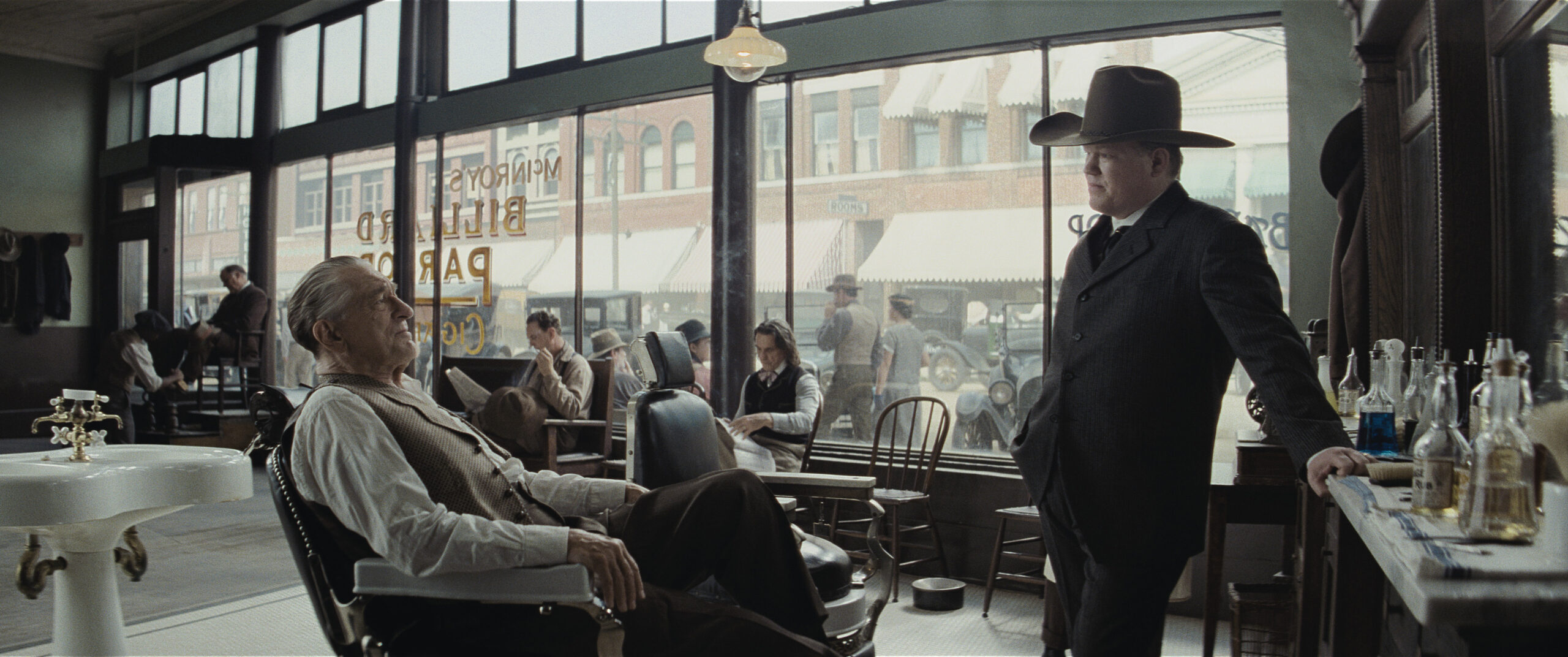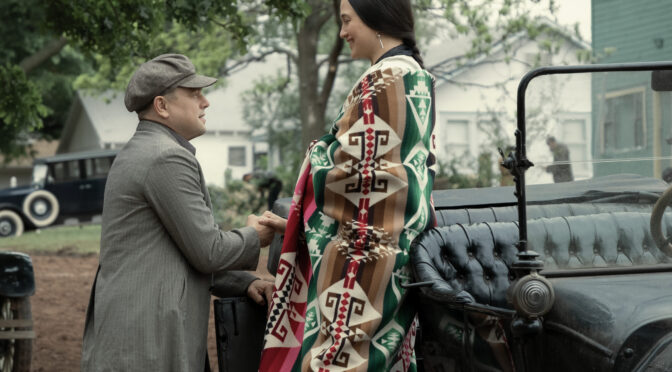 Cinematic depictions of historical crimes need to tread an ethical tightrope, a path that lays out what heinousness merits dramatic scrutiny whilst not being exploitative, voyeuristic, or sensationalist. KILLERS OF THE FLOWER MOON achieves this delicate balance and finds room to question the roles of everyone behind the camera and in front of the screen. Martin Scorsese’s favourites play slightly against type, and Lily Gladstone provides the emotional core in what may be one of the most outstanding entries in Scorsese’s lengthy filmography.
Cinematic depictions of historical crimes need to tread an ethical tightrope, a path that lays out what heinousness merits dramatic scrutiny whilst not being exploitative, voyeuristic, or sensationalist. KILLERS OF THE FLOWER MOON achieves this delicate balance and finds room to question the roles of everyone behind the camera and in front of the screen. Martin Scorsese’s favourites play slightly against type, and Lily Gladstone provides the emotional core in what may be one of the most outstanding entries in Scorsese’s lengthy filmography.
In the film’s opening segments, the camera sweeps across a verdant but stark landscape in Oklahoma, one fitting for a story that will chronicle the people of a land suddenly abundant with riches that will strip it of its very life. Scorsese’s oft-used slow motion chooses to linger on Osage dancing in a spurt of oil, a celebratory-seeming moment that still comes with a sense of foreboding. The black gold almost feels like chum in the water: an accelerant for the feeding frenzy of predators that will descend upon the people and land. The story then covers a long period related to the Osage Nation murders, where members of the Osage Nation in Osage County, Oklahoma, were systematically murdered to funnel their oil rights – and enormous wealth – towards envious white men.
“Scorsese’s oft-used slow motion chooses to linger on Osage dancing in a spurt of oil, [where] black gold almost feels like chum in the water: an accelerant for the feeding frenzy of predators that will descend upon the people and land.”
As the film’s central narrative clicks into gear, Ernest Burkhart (Leonardo DiCaprio), one such white man and former infantry cook, disembarks into the now-developed landscape and the ensuant money-grabbing chaos, to connect with his uncle William ‘King’ Hale (Robert De Niro). Hale presents himself as a friend and benefactor to the local Osage (many of whom are not given control of their abundant finances). Still, it doesn’t take long for him to suggest to Ernest that he find himself a Native American wife, which Ernest enthusiastically acts upon. There is a genuine spark of attraction and love between Mollie Kyle (Lily Gladstone) and Ernest, but the film makes Ernest’s criminality clear from early on, as well as Hale’s insidious accumulation of power and wealth that remains hidden in the shadows.
The conversation between the two men about money, women, and the local Osage is the first indication of the slightly subversive approach – within Scorsese’s filmography, at least – to the two men’s performances. De Niro’s most famous roles have an element of the caged beast about them: the violence behind the eyes of Travis Bickle as he addresses the mirror in TAXI DRIVER, the emotional and physical powder keg of RAGING BULL’s Jake LaMotta, or the criminal delusional ambition of Rupert Pupkin in THE KING OF COMEDY. Even some of De Niro’s more successful comedic roles, such as MEET THE PARENTS, lean on an effortlessly communicated threatening undercurrent that rubs up against outward restraint. KILLERS OF THE FLOWER MOON presents a much more insidious Scorsese antagonist for De Niro to inhabit and is perhaps his best performance this century. What seems disturbing about Hale is the pre-meditated nature of everything he seems to do. At every turn, De Niro superbly imbues his lines with a sense of foresight, that Hale has thought deeply about the exploitation he engenders and meticulously about the suffering he will have wrought vicariously through others. The delivery is calm to the point of eerie.

“KILLERS OF THE FLOWER MOON presents a much more insidious Scorsese antagonist for De Niro to inhabit and is perhaps his best performance this century. [De Niro conveys] that Hale has thought deeply about the exploitation he engenders and meticulously about the suffering he will have wrought vicariously through others.”
DiCaprio’s Ernest is also an interesting about-face for the actor, playing the intellectually blunt, dull instrument to Hale’s sharp and precise scalpel, in contrast to roles in THE AVIATOR and THE DEPARTED. However, DiCaprio’s work really shines in providing part of the platform for Lily Gladstone. Mollie is a self-assured woman with a deep sense of commitment and loyalty. Gladstone’s glances and changes in body language make Mollie’s downward spiral at the hands of her uncle-in-law, abetted by her husband, all the more potent. As the film concludes, a scene between her and DiCaprio is especially brutal, as it carries the weight of everything she has portrayed until then.
However, it can be argued Gladstone’s role is a supporting one to DiCaprio’s, and this slight disconnect highlights one of the key strengths of KILLERS OF THE FLOWER MOON (or perhaps a pitfall it avoids). Although depicting the Osage Nation murders, Scorsese does not attempt to tell the story of the Osage themselves during this period. However, when focusing on the white men who perpetrated the crimes, there is no hint of redemption, and any sense of remorse is wrapped up as hypocritical self-delusion by the time the film ends. This approach allows the film to reflect more meaningfully on the callousness that goes hand in glove with greed and the prejudice that leads to seeing anything that goes against an artificially imposed ‘natural’ order as an affront. The latter aspect is communicated in casually jarring ways, with racist language peppering conversations and small inserts like a brief shot of the KKK marching in a street parade. The script’s frequent dialogue references to the 1921 Tulsa race massacre make it clear the societal character depicted extends far beyond the exact racial and economic permutations represented here (that event itself was a historical stain little known to international or even American audiences until the 2019 Watchmen limited series).
“All of this is also utilised to underscore the dysfunction of America as a result of the pursuit of wealth; the warping of ambition into exploitation, ingenuity into criminality, and dreams into delusions.”
All of this is also utilised to underscore the dysfunction of America as a result of the pursuit of wealth; the warping of ambition into exploitation, ingenuity into criminality, and dreams into delusions. It is made clear at several points that Ernest seems to have genuine love (of a sort) for his wife and family, which makes his complicity all the more galling and Hale’s machinations even more deeply exploitative and cold. That deep sense of entitlement and greed will corrupt even familial ties. De Niro’s Hale also espouses a worrying opinion which is as accurate of modern examination of events as it is of events of the time: “There might be a public outcry….but they forget.”
The final trick pulled by KILLERS OF THE FLOWER MOON is to take this historical incident and make its portrayal contemporary and reflexive. A late framing device questions the role of filmmaking itself (and, by extension, the dramatisation of real tragedies and crimes), tying the depiction of suffering to a crass commercialism that questions whether the victims are still being preyed on decades (or even an entire century) later.
KILLERS OF THE FLOWER MOON approaches the atrocities from a particular standpoint, centring Ernest Burkhart, which undoubtedly takes some emphasis away from the Osage viewpoint. However, what it does with that angle is focus an angry and sad lens upon it and combine it with a script which questions the complicity of entertainment and society in injustice. By refracting these broader points through the prism of a personal story, the film makes that account echo and resound strongly over a century later.

